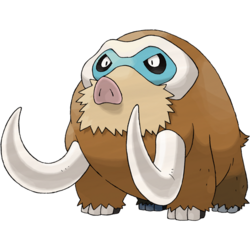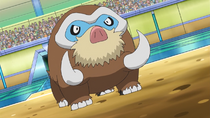From Bulbapedia, the community-driven Pokémon encyclopedia.
Mamoswine (Japanese: マンムー Mammoo) is a dual-type Ice/Ground Pokémon.
It evolves from Piloswine when leveled up while knowing Ancient Power. It is the final evolution of Swinub.
Biology
Mamoswine resembles a wooly mammoth crossed with a boar. Its brown fur is very thick to endure harsh cold and protect from snow and ice. Its tusks, which are smaller on a female Mamoswine than on a male, are made of pure, solid ice. Mamoswine has a blue mask-like pattern with a white rim around its face. The fur on its muzzle is tan and shaggy, and its nose resembles that of a pig. Mamoswine's feet are black with three thick claws, and its tail is small. It can endure harsh cold and hunger for an almost indefinite amount of time, as indicated by a ten-thousand-year-old specimen reviving. Mamoswine lived all around the world during the last ice age, but its population thinned when the climate grew warmer.
In the anime
Major appearances
Dawn has a Mamoswine that evolved from a Piloswine in A Breed Stampede!.
Other
A herd of Mamoswine appeared in Giratina and the Sky Warrior with Regigigas.
A Mamoswine appeared in Survival of the Striaton Gym! under the ownership of Morana.
Minor appearances
Pokédex entries
| Episode
|
Pokémon
|
Source
|
Entry
|
| DP106
|
Mamoswine
|
Dawn's Pokédex
|
Mamoswine, the Twin Tusk Pokémon and the evolved form of Piloswine. Distinguished by its large tusks, its weight is more than five times that of Piloswine, and is less commonly found since the end of the ice age.
|
|
| Episode
|
Pokémon
|
Source
|
Entry
|
| BW091
|
Mamoswine
|
Georgia's Pokédex
|
Mamoswine, the Twin Tusk Pokémon. Since the Ice Age, the Mamoswine population has gotten smaller as the climate has warmed. Its tusks are made from ice.
|
|
In the manga

Mamoswine in Pokémon Adventures
In the Pokémon Adventures manga
Platinum caught a Mamoswine and gave it to Diamond without using it, as it reminded her of the boy. He nicknamed it "Moo."
In the Pokémon Diamond and Pearl Adventure! manga
Koya has a Mamoswine was used in the battle against Hareta.
In the TCG
- Main article: Mamoswine (TCG)
Game data
Pokédex entries
| This Pokémon was unavailable prior to Generation IV.
|
|
|
|
|
|
|
| Generation IV
|
|
| Diamond
|
Its impressive tusks are made of ice. The population thinned when it turned warm after the ice age.
|
| Pearl
|
{{{pearldex}}}
|
| Platinum
|
A frozen one was dug up from soil dating back 10,000 years. It woke up to much amazement.
|
| HeartGold
|
A frozen Mamoswine was dug from ice dating back 10,000 years. This Pokémon has been around a long, long, long time.
|
| SoulSilver
|
It flourished worldwide during the ice age but its population declined when the masses of ice began to dwindle.
|
|
|
| Generation V
|
|
| Black
|
A frozen one was dug up from soil dating back 10,000 years. It woke up to much amazement.
|
| White
|
{{{whitedex}}}
|
| Black 2
|
When the temperature rose at the end of the ice age, most Mamoswine disappeared.
|
| White 2
|
{{{white2dex}}}
|
|
|
| Generation VI
|
|
| X
|
A frozen Mamoswine was dug from ice dating back 10,000 years. This Pokémon has been around a long, long, long time.
|
| Y
|
Its impressive tusks are made of ice. The population thinned when it turned warm after the ice age.
|
|
|
Game locations
| This Pokémon was unavailable prior to Generation IV.
|
|
|
|
|
|
|
|
|
|
|
|
|
In side games
Pokémon Global Link promotions
| Games
|
Event
|
Language
|
Location
|
Level
|
Distribution period
|
|
|
Global Link Mamoswine
|
Japanese
|
PGL
|
34
|
December 20, 2010 to May 31, 2011
|
|
|
Global Link Mamoswine
|
Korean
|
PGL
|
34
|
July 1 to August 24, 2011
|
|
|
Global Link Mamoswine
|
Spanish
|
PGL
|
34
|
October 13, 2011 to January 19, 2012
|
|
|
Global Link Mamoswine
|
French
|
PGL
|
34
|
October 19, 2011 to January 19, 2012
|
|
|
Global Link Mamoswine
|
German
|
PGL
|
34
|
October 19, 2011 to January 19, 2012
|
|
|
Global Link Mamoswine
|
Italian
|
PGL
|
34
|
October 19, 2011 to January 19, 2012
|
|
|
Global Link Mamoswine
|
English
|
PGL
|
34
|
October 20, 2011 to February 16, 2012
|
Stats
Base stats
| Stat
|
Range
|
| At Lv. 50
|
At Lv. 100
|
110
|
|
170 - 217
|
330 - 424
|
130
|
|
121 - 200
|
238 - 394
|
80
|
|
76 - 145
|
148 - 284
|
70
|
|
67 - 134
|
130 - 262
|
60
|
|
58 - 123
|
112 - 240
|
80
|
|
76 - 145
|
148 - 284
|
Total: 530
|
Other Pokémon with this total
|
- Minimum stats are calculated with 0 EVs, IVs of 0, and (if applicable) a hindering nature.
- Maximum stats are calculated with 252 EVs, IVs of 31, and (if applicable) a helpful nature.
|
Pokéathlon stats
Type effectiveness
| Under normal battle conditions in Generation IX, this Pokémon is:
|
|
|
|
|
|
|
|
|
|
|
|
|
Learnset
|
|
|
|
- Bold indicates a move that gets STAB when used by Mamoswine
- Italic indicates a move that gets STAB only when used by an Evolution of Mamoswine
- Click on the generation numbers at the top to see level-up moves from other generations
|
Side game data
Evolution
Sprites
Trivia
- Mamoswine's Pokémon Diamond, Pearl, SoulSilver and Y Pokédex entries are a reference to how woolly mammoths became extinct.
- Mamoswine and its evolutionary family can hit the most Pokémon with a super effective move they gain STAB from, with nine: Flying, Poison, Ground, Rock, Steel, Fire, Grass, Electric, and Dragon.
- Mamoswine would have been obtainable in both Generation II and Generation III if it had existed, as it was possible for Piloswine to learn AncientPower in both generations. It shares this trait with Lickilicky.
- Mamoswine and its pre-evolutions are the only Pokémon weak to the types of all three starter Pokémon.
Origin
Mamoswine appears to be based on a combination of a woolly mammoth and a boar.
Name origin
Mamoswine is a combination of mammoth and swine.
Mammoo may be a combination of mammoth and ぶうぶう būbū (onomatopoeia for oinking).
In other languages
| Language
|
Title
|
Meaning
|
 Japanese Japanese
|
マンムー Manmoo
|
From mammoth and ブーブー būbū
|
 French French
|
Mammochon
|
From mammouth and cochon
|
 Spanish Spanish
|
Mamoswine
|
Same as English name
|
 German German
|
Mamutel
|
From Mammut and Zottel
|
 Italian Italian
|
Mamoswine
|
Same as English name
|
 Korean Korean
|
맘모꾸리 Mammokkuri
|
From Mammoth and 꿀꿀 kkulkkul
|
 Mandarin Chinese Mandarin Chinese
|
象牙豬 / 象牙猪 Xiàngyázhū
|
From 象牙 xiàngyá and 豬 zhū
|
 Cantonese Chinese Cantonese Chinese
|
|
|
|
|
|
|
|
|
|
Related articles

|
This Pokémon article is part of Project Pokédex, a Bulbapedia project that aims to write comprehensive articles on each Pokémon species, as well as Pokémon groups and forms.
|












































































































































